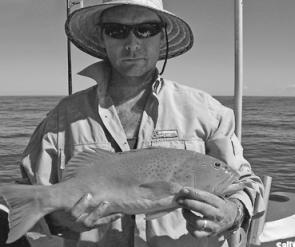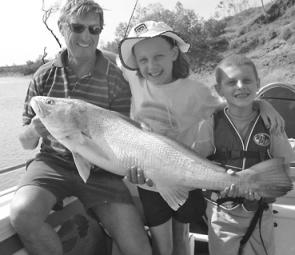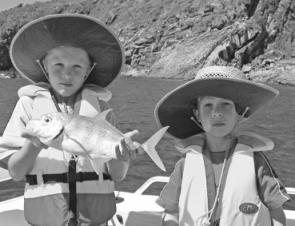Our mild summer should heat up in February – above and below the water surface.
Many Central Queensland fishers have been getting ready for the opening of the barramundi season. Recent reports have included plenty of barra sightings in The Fitzroy over a wide area.
Recently I went searching for mangrove jack and fingermark along the rock walls downstream from Gavial Creek and returned home happy with no fish. I was happy because after fishing with the smallest lure in my tackle box (a gold Richoes Little Terror), I was finally able to stop catching barra. Most of the fish were only 450-500mm with the odd big fish exceeding 800mm. I don’t intentionally chase barramundi in the closed season so any barra unlucky enough to be hooked were let go without leaving the water. If you don’t need to remove a fish from the water for release, don’t take it out. After seeing some bad hook accidents over the years, we only use barbless hooks on our lures. Testing in previous years has proven that barbless hooks won’t lose any more fish than barbed hooks with the main difference being the ease of releasing fish or unhooking yourself.
The much needed rain has fallen short of expectations and only a few hundred millimetres will give the systems a decent flush. A little more rain should push the prawns out of the smaller creeks and into bigger systems and the bay. The fresh we have had has given prawns and crabs plenty of food, which can only mean bigger prawns and crabs. The weather doesn’t have to be perfect to go crabbing and prawning. Small prawns were caught at lots of places last week and plenty of the local creeks are showing signs of a decent season coming. There were a few prawns in the Fitzroy, Pumpkin Creek, Coorooman Creek, Ross Creek, Waterpark Creek, Greenslopes and Solero, during the low tides of the previous week. In the next week or so they will probably be big enough for a decent feed if we get some fresh.
Salmon, grunter, mangrove jack, fingermark, barra, flathead, trevally, whiting and queenfish have been around lately and are worth chasing in most of the region’s estuaries. Stacks of baitfish schools have been spotted, so take the cast net.
The Fitzroy River is Yeppoon’s salmon capitol. Big fingermark were taken in The Port Alma area from The Narrows and back up into the river. Coorooman Creek has heaps of blubberlip this month which taste okay. They have been feeding towards the mouth and are much cleaner than usual. Corio Bay and Waterpark Creek have had some queenies and small trevally taken on Flashas at The Heads.
Offshore grunter tend to school around The Pinnacles, Cape Capricorn and Cape Manifold. The grunter usually arrive four days before to four days after the moon.
Look for Spanish mackerel at Farnborough, Iron Pot, Rita Mada and Corio Heads in February, though the better quality size fish will be out on the wider grounds. Decent catches of school mackerel just off the local beaches and headlands might occur on calmer mornings.
The schools of spotted mackerel have been moving along the coast and are going to start showing up at some of their usual spots. A few anglers have reported quality fish at The Pinnacles and Flat. Spotties will begin to increase in numbers from mid February into March. Doggies have also started moving in from the wider areas. They will also rise in quantity as they travel through the local area.
Coral trout, fingermark, Moses perch, matty cod and sweetlip are all featuring in catches around The Keppels. The amount of decent trout in close has increased with reports of bigger fish than those caught near the islands for years. Trout around 500mm were the average with several larger specimens recorded. Increasing information shows that lots of the local species are on the climb since all of the changes in closures, zoning and fishing practices.
Live bait, dead bait or lures is a question that I am asked often. Lures are fast gaining ground on the dead bait set and live bait is close behind. Dead bait is the easiest option and it probably catches a fair share of the fish caught. Live bait takes a bit of work to find and then keep them alive. Aerators, live bait tanks and buckets have their place in any boat along with bait jigs and cast nets. The pressures of modern living mean every minute of a fishing trip counts, so getting livies cuts into fishing time. These days tackle shops get pretty good frozen bait from prawns, pillies, squid and worms to specialist stuff like bonito, ribbonfish and gar – the range is endless. A mackerel chase is incomplete without pilchards and the same goes for a tailor run.
Lures can turn around a bad day in no time when they are presented to the fish in an enticing way. Barramundi, cod, bream, salmon, mangrove jack, queenfish, trevally and flathead are usually the top species targeted by trollers or casters with lures in estuaries. Outside, most of the fish nailed on lures are pelagic bottom bashers that normally take bait. These fish will take whatever is in reach whether it is bait or a lure. If you fish a particular spot and you know the area well, soaking a bait can be the way to go. To cover lots of country in a day, lures win hands down. Big systems have too many structures to anchor up and spend time at each one where as with lures you can have 20-30 casts and move on. I think every method has its place depending on your attitude, the amount of time you have or the availability of live bait, which way you go.
Some of the area’s crab thieves had their world shaken by an upset local recently. I haven’t got all the details yet but upon finding a sharefarmer lifting his pots the victim produced a shotgun and let one go over their heads and another into the transom. Though I don’t condone it I understand how frustrating it can be when one of the river pro-crabbers had 25 $50 pots ripped off in a few months.
The Capricorn Coast Local Marine Advisory Committee and Capricorn Sunfish Queensland have produced new pamphlet called Boating and Fishing in the Waters of the Capricorn Coast. Marine Parks and the Fisheries Patrols should have some copies on hand. The pamphlet includes a photo map with boundaries drawn in, info on closures, where to go and not to go, all the relevant phone numbers you need on the water and a brief how to release fish by Bill Sawynok and stacks more. Get a hold of one to keep in the boat.
Reads: 2567
Andrew Smallwood caught this trout around the Keppels.

Ethan Sladden with his first black jew. The fish was caught while fishing with his sister Georgie and his pop Tom.

Daniel Danowski with his first trevally caught over the summer holidays.




